Mariani's Virtual Gourmet Newsletter
June 26, 2011
Follow @VirtualGourmet

THIS WEEK
EATING AND DRINKING IN TURIN, PART TWO
by John Mariani
NEW YORK CORNER: ASELLINA
by John Mariani
MAN ABOUT TOWN: TRUFFLE HUNTING IN LE MARCHE
by Christopher Mariani
NOTES FROM THE WINE CELLAR: ITALIAN WINE SALES SOAR
by John Mariani
Mariani's Quick Bytes
If you would like to be featured in our Quick Bytes section please visit our media page at www.JohnMarianiMedia.com
*Paid Advertisements*
|
New York Celeb Chef at French Revolution
Festival in Riviera Maya, July 11 - 23
From July 11-23, a festival
honoring the anniversary of the French Revolution will be held at AAA
Five Diamond Grand Velas Riviera Maya. The resort's gourmet restaurant
Piaf will be showcasing the talents of New York City's
Madison Bistro owner and Maitre Cuisinier de France, Chef Claude
Godard. Alongside Piaf's Executive Chef Michele Mustiere, Chef Godard
will prepare a 5-course tasting menu featuring Sautéed Foie Gras
w/ Artichoke Mousseline and white truffle; Hazelnut-butter Roasted Sea
Bass, and a decadent chocolate dessert served with poached raspberries.
Available to resort guests at no charge, $1200 pesos (approx. $100USD)
for non-hotel guests. 1-888-323-2776; velasresorts.com. |
|
Bond 45
NYC's Times
Square
fine-dining favorite Bond 45 (154 West 45th Street, 212-869-4545, www.bond45.com) is
offering an unbeatable $15 Lunch Special at the bar from 11:30am to 4pm
Monday to Friday. From pleasing pasta dishes to succulent seafood and
steak items, you can enjoy a different and delicious dish each day from
Culinary Director Brando De Oliveira. On Mondays indulge in classic
Spaghetti & Meatballs; on Tuesdays savor Penne with Sausage
Amatriciana; on Wednesdays, a tasty Tagliatelle with Filet Mignon
Braciola; on Thursdays, Gramigna with Pulled Pork Ragu; and on Fridays,
a flavorful Orecchiette with Red Wine Braised Calamari. |
|
Le Caprice
On weekdays from 12pm to 3pm at the modern Le Caprice (795 Fifth Avenue,
212-940-8195,www.lecapriceny.com),
you
can
enjoy
Executive
Chef
Ed
Carew's
"lunch at the bar" menu with
flavorful offerings like a Scotch Egg with celery salt ($8), Scottish
Smoked Salmon with lemon and capers ($14), and an exquisite Welsh
Rarebit ($10). And with Central Park right across the way, Le Caprice
is an ideal spot for a midday meal. |
|
Columbus Tavern
Columbus Tavern's (269 Columbus Avenue, NY 212-873-9400,
www.columbustavern.com) old-world feel and delectable lunch menu
can be enjoyed at their 100 year-old mahogany bar. Executive Chef Phil
Conlon offers playful dishes like BLT Dumplings with spicy mustard and
salted radishes ($7.50), Triple Mac & Cheese with spiral pasta and
roasted tomatoes ($11), and ChefPhilly's Cheese Steak ($13). While
there, you can also enjoy unique cocktails inspired by Upper West Side
buildings like The Ansonia and The Dakota ($12 each). |
|
Benjamin Steakhouse, White Plains, NY
Benjamin Steakhouse: White Plains NY seeks an energetic, self-motivated Events/Marketing professional to promote the restaurant and handle all banquet sales/private events. Ideal candidate must have excellent communication skills, as well as a minimum of 1-2 years of professional experience in events, sales, or within the hospitality industry. Strong sales and administrative skills are key, as well as attention to detail, good organizational skills and the ability to multitask. Self-motivation is crucial! Must be able to promote, book, and coordinate events from start to finish!! Familiarity with the area is a plus! Interested candidates may email a resume, as well as a description as to why you would be a good fit to cynthia@benjaminsteakhouse.com. |
Place your Quick Byte Here |
Eating
and Drinking in Turin
Part Two
by John Mariani
Photos by Galina
Dargery
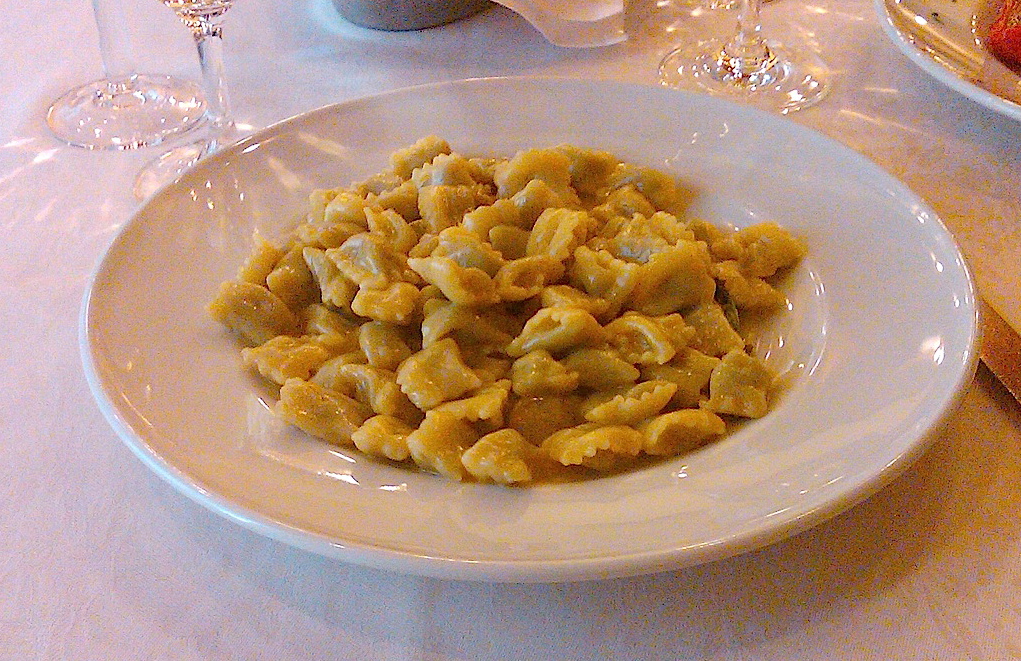
Piedmont's classic agnolotti del plin, at Monferatto, Turin
Not
far
from
Turin's
center
sprawls
the
Turin
food
market,
where
at
least
one
generation
of
Italians
who
have
never
known hunger come to buy
amazingly
inexpensive fruits and vegetables—one euro for a kilo of lemons!—that
are to
sight and smell of the highest quality. There
are
so
many
competing
outdoor
stalls
selling
the
same
long-stemmed
artichokes
and
cardoons,
oranges
as
bright
as
the
sun,
wild
mushrooms
in
profusion, so vendors sing out praise of their wares as they slice off
the
outer skins and stalks of the asparagus and fennel.
Inside
are the butchers and fishmongers, a horsemeat stall, and myriad shops
selling
cheeses from all over Italy, with 48 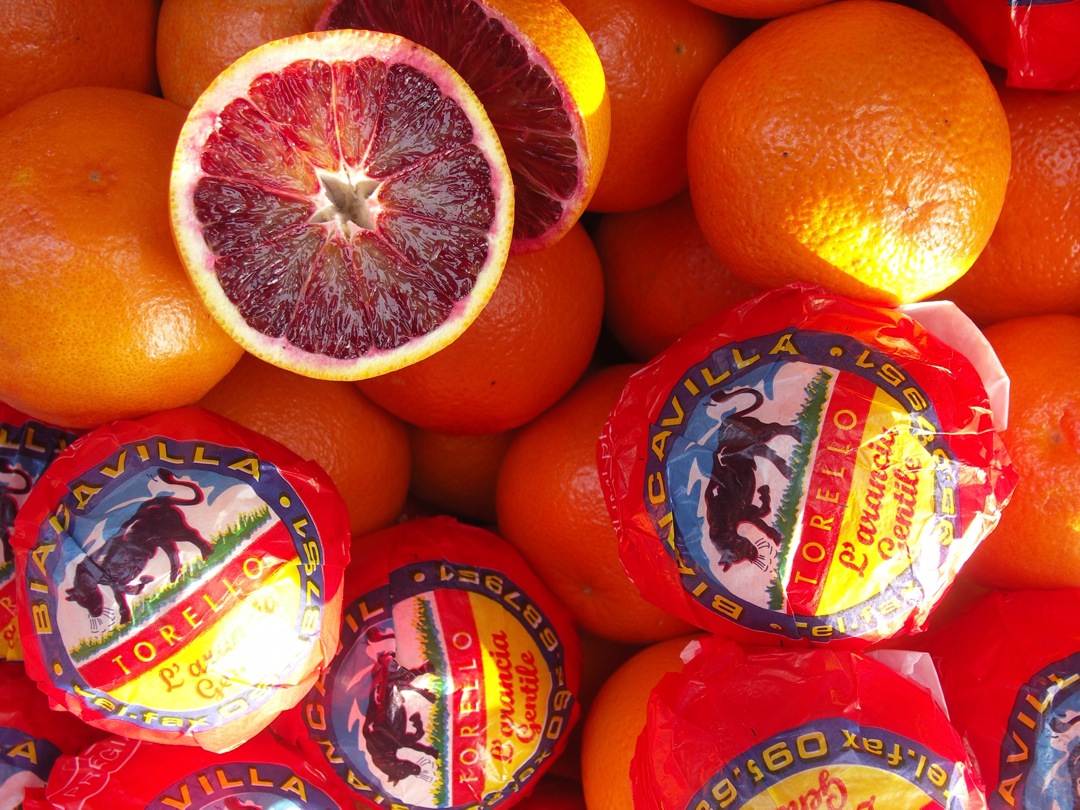 from Piedmont alone. Langoustines
and
red
mullets
glisten
on
beds
of
ice;
the
butchers
slice
the
hams
paper
thin
and
pull
down
sausages
from hooks; the good lighting shows it all off to best
advantage, and
the big room hums with people ordering amounts of food once
unimaginable to
their grandparents, who now join the throng.
from Piedmont alone. Langoustines
and
red
mullets
glisten
on
beds
of
ice;
the
butchers
slice
the
hams
paper
thin
and
pull
down
sausages
from hooks; the good lighting shows it all off to best
advantage, and
the big room hums with people ordering amounts of food once
unimaginable to
their grandparents, who now join the throng.
Also
nearby, just east of the Piazza Castello, is a delightful narrow street
called
Via Barbaroux whose food shops and groceries are quite old and
very small,
usually specializing in a few items, such as cheese or fresh pasta,
wine and
coffee beans. Here the personal
touch and long familiarity between sellers and buyers makes for a
generational
trust and fidelity.
There
is
a
distinctly
Torinese,
or
at
least
Piedmontese,
gastronomy,
one
that
observers—not
least
other
Italians—will
say
is
more
than
a
little
tinged
with
French culinary ideas. The farms
produce excellent fruits and vegetables, the Po Valley produces the
majority of
Italy’s rice, and in autumn the magical appearance of Alba’s white
truffles
occurs in the oak, poplar and hazel tree forests. Excellent freshwater
fish is
brought out of Lake Maggiore, and cold weather makes game dishes,
usually
braised, highly desirable. The region’s beef, called razza
piemontese, is well regarded everywhere in the country, and
there is an official government list of more than 100 different types
of salumi, many artisanal. Every
bit
of
the
pig
is
used,
so
that
the
frisse of Cuneo is rich
with offal meat, while testa in cassetta di Gavi is made from
the head. Lonzardo is a
loin
of seasoned pork, and brod is made
with the blood and offal, flavored with cinnamon and fennel.
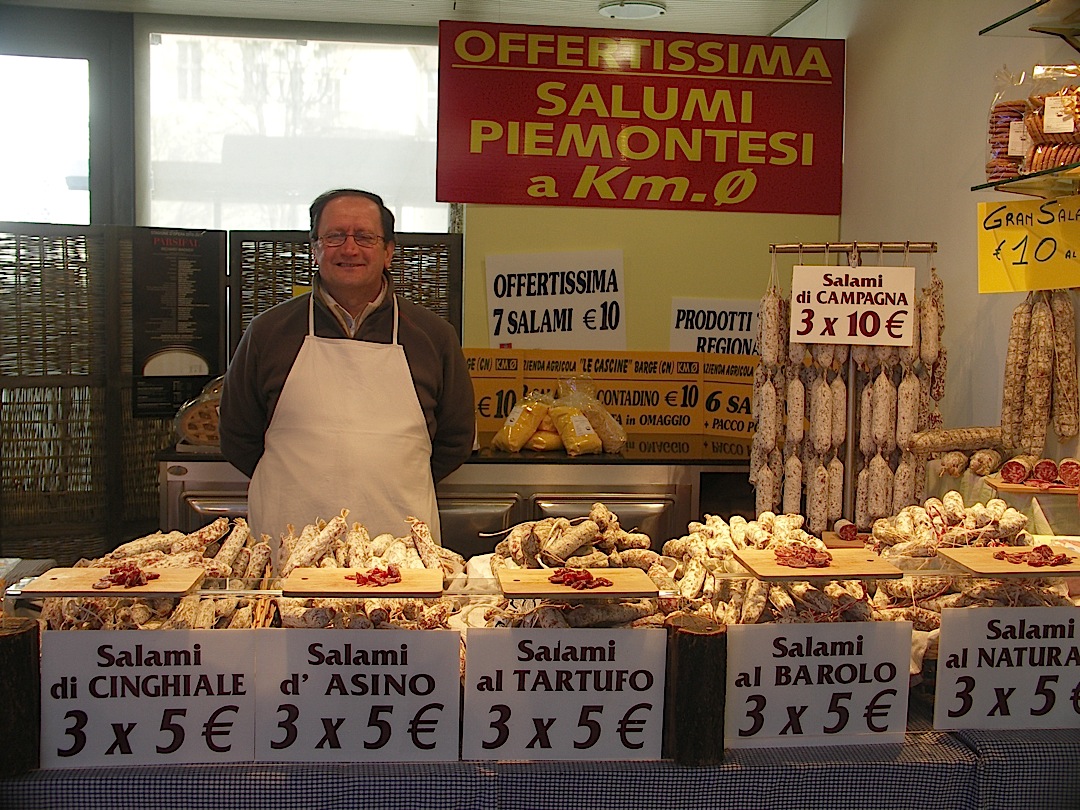 As
in
most
of
northern Italy, the Torinesi have a love-hate regard for
polenta,
for this cornmeal porridge was once the bland gruel of the very poor,
whose
unremitting daily appearance at the kitchen table reminded people of
less
fortunate times, when pellagra was a deficiency disease of children who
ate
little or nothing but polenta while growing up. Those days are long
gone, but
it is now rare that a Piedmontese cook would serve polenta on its own,
rather
than as the underpinning of another ingredient like braised meat or
vegetables.
As
in
most
of
northern Italy, the Torinesi have a love-hate regard for
polenta,
for this cornmeal porridge was once the bland gruel of the very poor,
whose
unremitting daily appearance at the kitchen table reminded people of
less
fortunate times, when pellagra was a deficiency disease of children who
ate
little or nothing but polenta while growing up. Those days are long
gone, but
it is now rare that a Piedmontese cook would serve polenta on its own,
rather
than as the underpinning of another ingredient like braised meat or
vegetables.
Of course, the
wines of Piedmont have long been among Italy’s finest, at least since
post-war
winemakers and contemporary innovators like Angelo Gaja, Bruno Giacosa,
Aldo
Conterno, and others raised the bar within the region to concentrate on
terroir
over quantity. The wide range of
Piedmont wines—barbera, dolcetto, nebbiolo, barolo, barbaresco, and
many
others—is too immense to speak of here, but a visitor can taste his way
through
dozens of fine examples from the list of just about any restaurant in
Turin.
Indeed, more
than most restaurateurs in Italy, the Torinesi proudly amass excellent
wine
lists, a requisite that is also very much in line with their civilized
self
image. Just as the baroque in
Turin is less flamboyant than in Naples and Palermo, so, too, the
restaurants
show a certain, very personalized restraint. “You
have
to
understand
that
the
Torinesi
both
respect
and
support
their
arts
and
music,”
Gianandrea
Noseda,
the
Milanese-born
artistic
director
and
conductor
of the Turin Opera told me in an interview.
“This is a
royal city with a strong devotion to refinement and it shows in their
cuisine
and restaurants.”
So,
too,
Laura
Maioglio,
owner
of
the
great
Piedmontese
restaurant
Barbetta
in New
York, whose father opened it in 1906, old me before I flew to Turin,
“It’s a
city of fine restaurants, not trattorie.
The Torinesi may go to their favorite
little spots, but the proud traditions of cucina
alla piemontese are being carried on in the ristoranti.”
While
the
distinctions
between
ristoranti and trattorie
have been considerably
blurred all over Italy, we did find t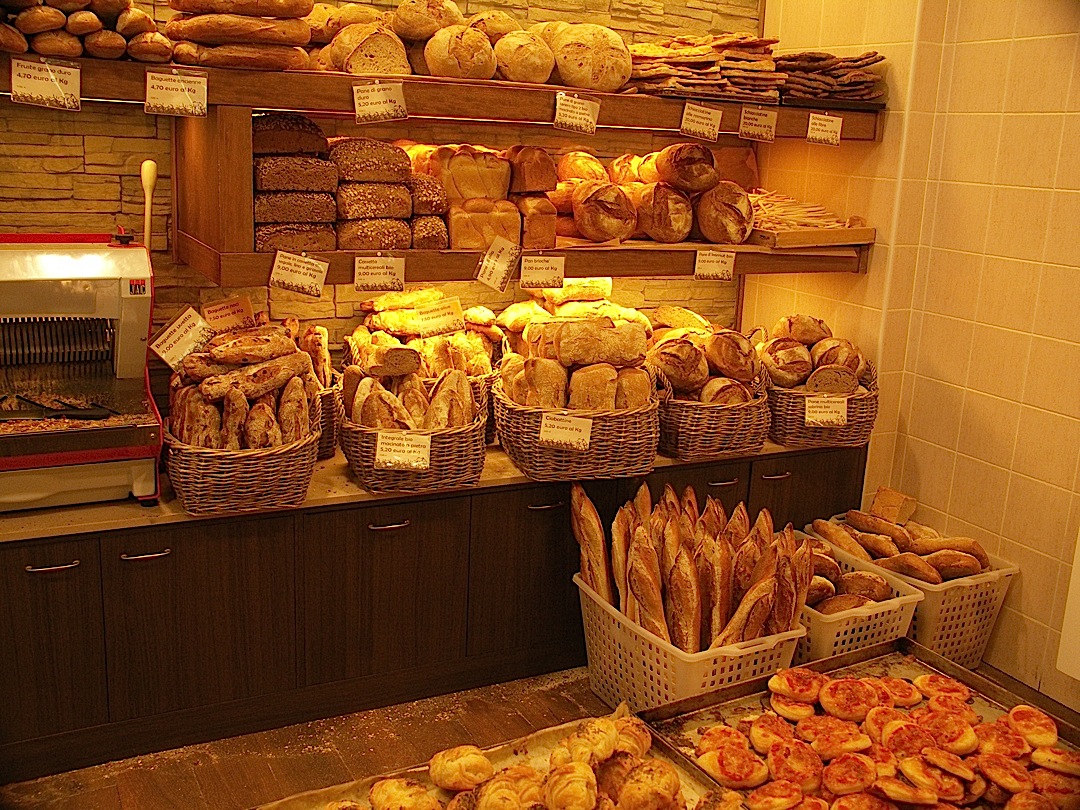 hat in Turin my lunches and
dinners were
carried out with a raffinato
hospitality everywhere we ate. Almost
every restaurant has tablecloths, at night they
light candles and
set down good silver and wineglasses. They are never very loud; people
dress
well; there are no t-shirted waiters, no brusque urgings for you to
relinquish
your table, and definitely no rap music or Lady Gaga being pumped into
the
room.
hat in Turin my lunches and
dinners were
carried out with a raffinato
hospitality everywhere we ate. Almost
every restaurant has tablecloths, at night they
light candles and
set down good silver and wineglasses. They are never very loud; people
dress
well; there are no t-shirted waiters, no brusque urgings for you to
relinquish
your table, and definitely no rap music or Lady Gaga being pumped into
the
room.
And
I
am
also
happy
to
comfort
those
who
fear
food
in
Italy
is
losing
its
regional
grip
and
traditions,
by
saying
that
this is absolutely not the
case in Turin, where tradition has a firm hold in the
kitchen. Indeed, it might be said that
Turin has 500 chefs all cooking the same seven sacrosanct dishes, which
would
be vitello tonnato; the veal tartare
called carne cruda; the tiny
meat-filled agnolotti del plin;
the egg-rich tagliatelle they call tajarin;
various
braised
brasato dishes; the lavish finanziera,
made
with
chicken
livers,
gizzards,
cockscombs,
and
porcini;
and
for
dessert,
a
Marsala-laced
cocoa
and
amaretti cookie
custard
called bonèt.
My
wife
and
I
ate
these
dishes
several
times
over
several
days—my
first
instinct
upon
arrival
was
to
eat
plin at every
meal to find the very best—but I was also looking for variety, unique
cooking,
and innovation. At the first
restaurant we visited, Neuv
Caval d' Bròns (below),
located
since
1948
above
its
own
beautiful
confectionery
on
the
Piazza
San
Carlo,
all
three
curiosities
were
satisfied,
not
least by an amuse sent
out by Chef Cristoforo Di Muro, of a single slice of culatello
ham, a spoonful of Castelmagro cheese with a few dots of balsamico,
and
a
mere
sip
of
Carpano
Antica
Formula
amaro,
which
proved
to
be
a
capital
way
to
spark
the
appetite.
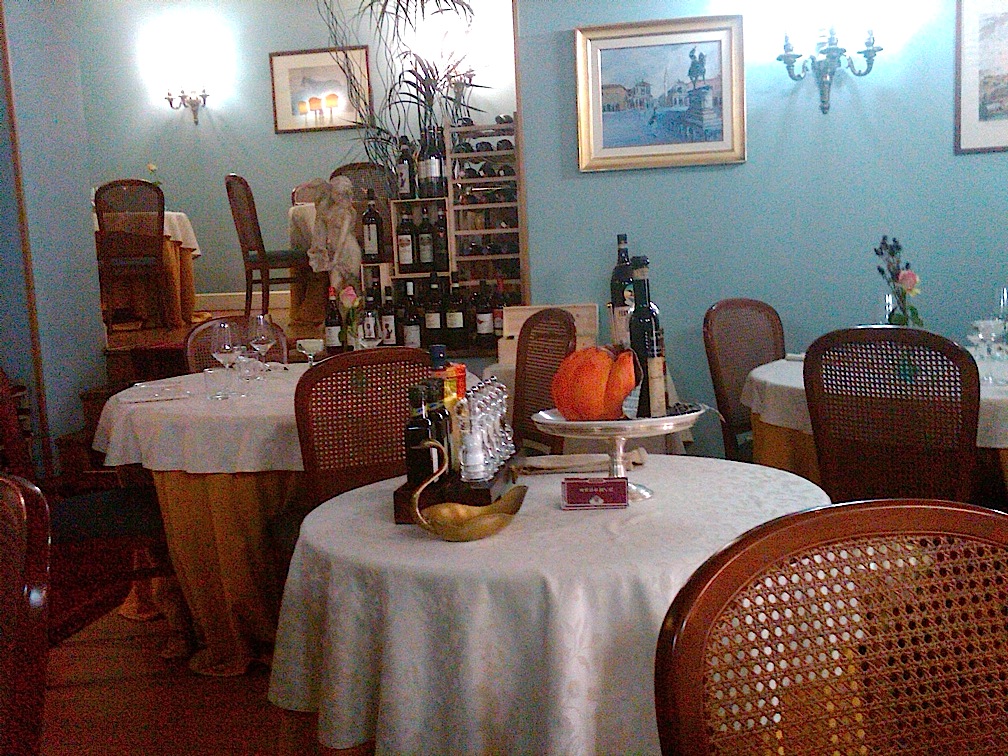 What
followed
was
a
quivering sformatino of
artichoke with foie gras, arugula, and pomegranate, and a hot fondue of
raschera cheese and Jerusalem artichokes
flavored with truffles. We then
had our first plin, at least our
first in Turin, which came, characteristically, in a simple but
luscious veal sugo with a touch of tarragon and a
sprinkling of Parmigiano—simple, tender and delicious, and, now the
case
throughout Italy, in a generous portion indeed. We
also
opted
for
venison
ravioli
with
a
rich
sauce
of
braised
beef
and
funghi porcini. Dessert
was
a
semifreddo of
nougat
with
rum sauce and a mousse of chocolate and hazelnuts in a vanilla custard
with
Morello cherries.
What
followed
was
a
quivering sformatino of
artichoke with foie gras, arugula, and pomegranate, and a hot fondue of
raschera cheese and Jerusalem artichokes
flavored with truffles. We then
had our first plin, at least our
first in Turin, which came, characteristically, in a simple but
luscious veal sugo with a touch of tarragon and a
sprinkling of Parmigiano—simple, tender and delicious, and, now the
case
throughout Italy, in a generous portion indeed. We
also
opted
for
venison
ravioli
with
a
rich
sauce
of
braised
beef
and
funghi porcini. Dessert
was
a
semifreddo of
nougat
with
rum sauce and a mousse of chocolate and hazelnuts in a vanilla custard
with
Morello cherries.
Caval
d’Bròns
(the
name
comes
from
the
bronze
horse
in
the
piazza)
is
a
ristorante,
polite,
quiet,
sedate, all
virtues we found in spades at the famous Ristorante
del
Cambio, here since 1757
and which, according to culinary historian Luciano Tamburini, “put
Turin on the
map of the Grand Tour to Italy.” The name
Cambio has never been satisfactorily explained,
but the
restaurant was well known to Casanova, Cavour, and Goldoni, and 19th
century society adopted it as requisite for a visit to Turin in the 19th
century. Its fame and
fortune es have been up and down ever since, but today Cambio, now
owned
by the
Turin Hotels International group, is still thronged with locals, opera
lovers,
and travelers on weekends.
On
a
Tuesday
evening
when
we
dined
there,
however,
the
luxuriously
appointed
dining
room
(below) was nearly 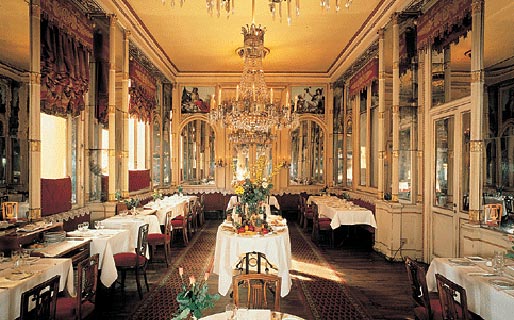 empty,
giving its restored Neoclassical wood
paneling,
paintings on glass by Bonelli, and baroque stuccos the ambiance of a
museum. Still, the service staff,
in dovetail coats, administered to our table as if we were honored
guests.
empty,
giving its restored Neoclassical wood
paneling,
paintings on glass by Bonelli, and baroque stuccos the ambiance of a
museum. Still, the service staff,
in dovetail coats, administered to our table as if we were honored
guests.
The
cuisine
at
Cambio
is
resolutely
Piedmontese,
with
a
continental
cast,
and
we
ordered
accordingly,
not
least
the
restaurant’s
famous risotto
alla
Cavour, which may well have been created at Cambio. It
is rice cooked in white wine, with a poached egg and Parmigiano to
enrich it.
We also enjoyed a delicately flavored cannelloni of cauliflower, and stinco di vitello, a succulent and
tender shank of veal braised in vegetables and wine, and for dessert
the
classic Marsala-spiked bonèt.
Photo courtesy of Ristorante di
Cambio
Most
of
our
other
meals in Turin were in less lavish, more casual places,
including
the amiable Ristorante
Monferrato across the river, with three pale yellow
rooms with pleasingly separated tables, by one o’clock 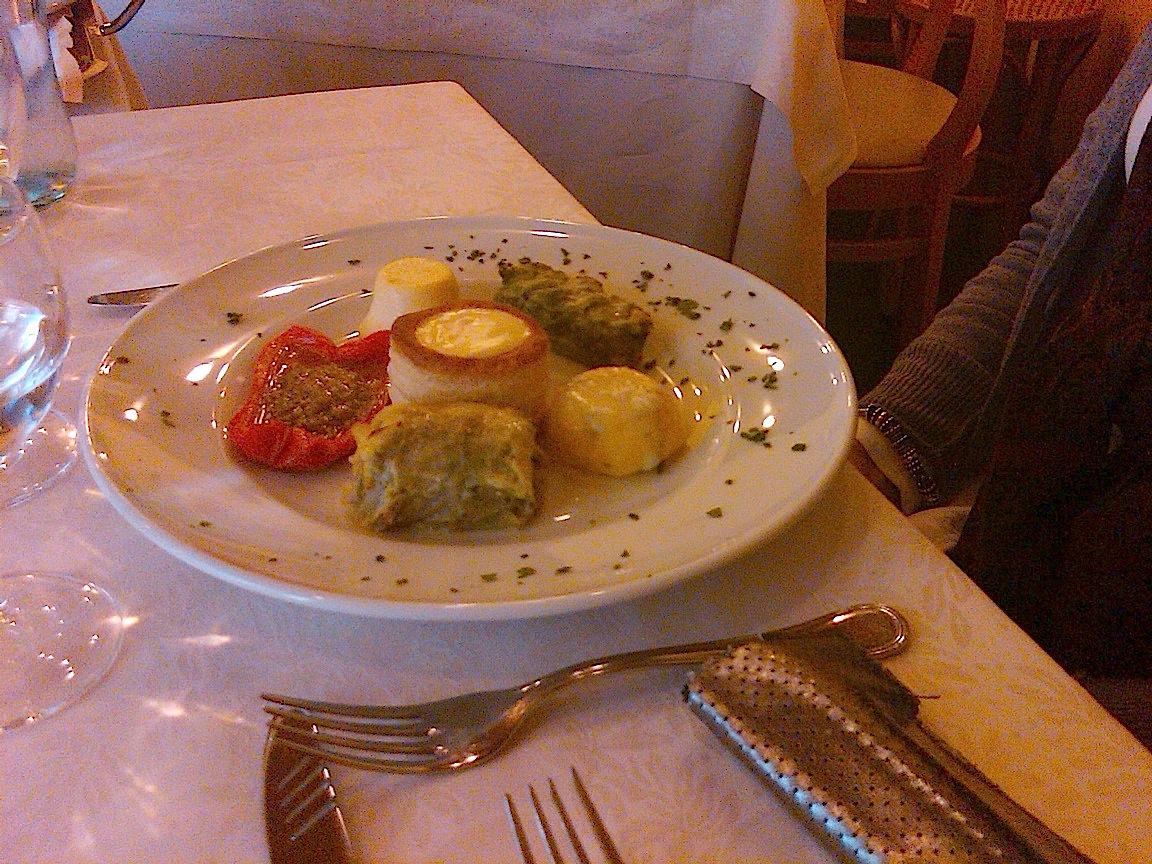 filled with
businessmen
scarfing up large portions of wonderfully pink carne cruda
and ladies out to lunch on a fine antipasto (left) of cooked
vegetables, a generous platter of stuffed zucchini, polenta with
Gorgonzola, a
spinach flan, cheese in puff pastry, red peppers with ground meat, and
simply
cooked cardoons. Here again, I
ordered the plin, this time with
butter and sage, and gnocchetti in a
rich sauce of Toma cheese, which was probably too much food, knowing
what was
to follow—a marvelous, steamy bollito
misto of beef, veal, and chicken, with condiments that included
sweet and
hot mostarda.
filled with
businessmen
scarfing up large portions of wonderfully pink carne cruda
and ladies out to lunch on a fine antipasto (left) of cooked
vegetables, a generous platter of stuffed zucchini, polenta with
Gorgonzola, a
spinach flan, cheese in puff pastry, red peppers with ground meat, and
simply
cooked cardoons. Here again, I
ordered the plin, this time with
butter and sage, and gnocchetti in a
rich sauce of Toma cheese, which was probably too much food, knowing
what was
to follow—a marvelous, steamy bollito
misto of beef, veal, and chicken, with condiments that included
sweet and
hot mostarda.
There
were
other
fine
meals,
some
more
successful
than
others,
all
resolutely
Piedmontese,
so
we
sought
out
restaurants’
specialties,
like
the
unusual
cod
ravioli
with butter and chives. at Sotto
la
Mole (below),  across from
the Cinema Museum.
Here, under a brick barrel vault ceiling, we also enjoyed an onion soup
so
thick with sweet onions, melted cheese, and soaked bread that the soup
was a
mere moistener. Fried rabbit with
artichokes was very good, crisp, and meaty, but the surprise on the
menu was to
find braised donkey (asino)
stew, which tasted a good deal like venison, served
with
yellow polenta. The menu, by the
way, is available in broken English, so that finanziera
is translated as “guts,” true enough but a bit
off-putting.
across from
the Cinema Museum.
Here, under a brick barrel vault ceiling, we also enjoyed an onion soup
so
thick with sweet onions, melted cheese, and soaked bread that the soup
was a
mere moistener. Fried rabbit with
artichokes was very good, crisp, and meaty, but the surprise on the
menu was to
find braised donkey (asino)
stew, which tasted a good deal like venison, served
with
yellow polenta. The menu, by the
way, is available in broken English, so that finanziera
is translated as “guts,” true enough but a bit
off-putting.
Modern—for
Turin—is
the
style
and cooking at Porta di
Po on the Piazza Vittoria. With its
polished black wood tables set with herbs, gray walls, and beautiful
glassware,
the owner Antonio Terre and Chef/partner Giorgio Marone (right) of this four year-old
restaurant takes great pride in obtaining the best
ingredients in a city full of them. We
thoroughly enjoyed a subtle vitello
tonnato here, the tuna sauce not too pronounced, the veal superb;
an order
of sugo-glossed tajarin whose dough
is made with 40 egg yolks; and plin eaten in a very
old-fashioned
way—cooked in a broth and served in a napkin, to be eaten one by one
with your
fingers. Photo
courtesy
of
Porta
di
Pio
The
name
of
the
very
popular
little
trattoria
Le
Vitel Étonné—is
a
French pun on
the Italian for 20-month old veal, vitelloni (also the
title of a 1953 Fellini movie)—on Via San Francesco da Paola. Always
packed
with locals, this is a fast-paced, friendly, youthful spot with bare
wooden
tables and paper mats. The food is modern, though anchored in
traditional
Piedmontese cooking, including 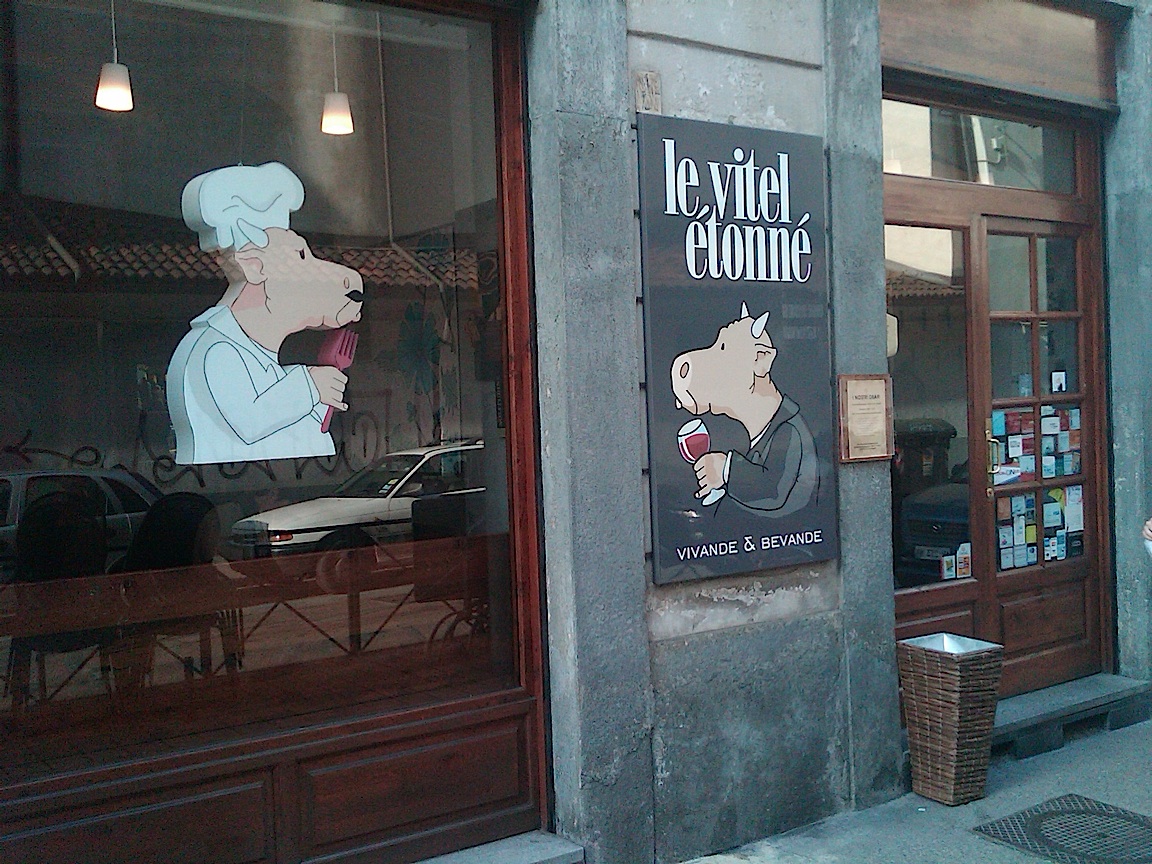 an
open-faced raviolo
with peppery rabbit sausage; an assertively spiced breast
of duck; and for dessert a very rich hazelnut torta lavished
with
golden
yellow
zabaglione.
an
open-faced raviolo
with peppery rabbit sausage; an assertively spiced breast
of duck; and for dessert a very rich hazelnut torta lavished
with
golden
yellow
zabaglione.
On
our
last
day
in
Turin
we
made
our
pilgrimage
to
EATaly,
set
so
far out of the
city center in the once declining industrial neighborhood of Lingotto
because
its backers needed so much space. EATaly is a big part of the
evolution
and
promotion of the Slow Food
Movement,
which Carlo Petrini began in nearby Alba, where he held the Salone del
Gusto
food exposition in the Lingotto Convention Center back in 1996. In
early 2007
they debuted what they bill as the “largest food and wine market in the
world”
within what the former Carpano Vermouth Factory.
I
need
not
go
into
the
Slow
Food
Movement’s
philosophy
of
biodiversity,
and
dedication
to
traditional
and
artisanal
foods
or
to
scratch
the surface
of what
is carried at EATaly. Suffice it
to say, all the food and wines and restaurants here are rigorously
Italian,
from the fresh burrata and dozens of
hams to the confections room 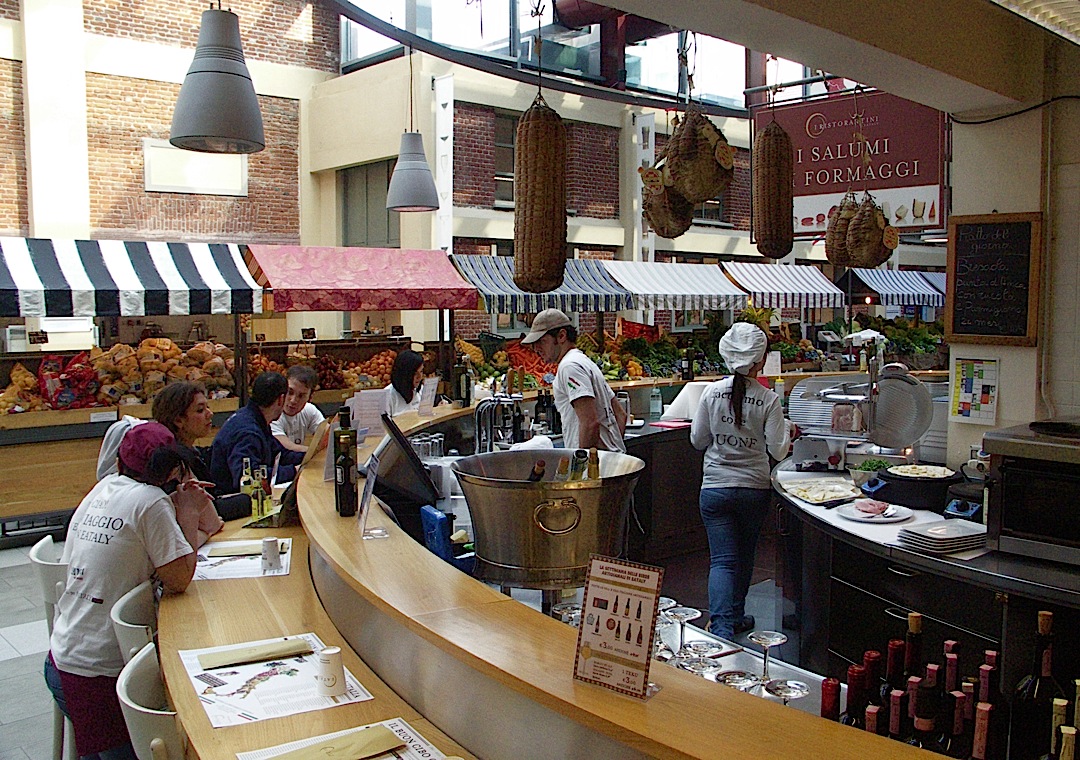 floor-to-ceiling
with
chocolates
and
candies,
biscotti
and
cakes,
and
a
seafood
stall
that
teems
with
dozens
of
species
of
fish,
clams,
oysters, shrimp, and langoustines.
floor-to-ceiling
with
chocolates
and
candies,
biscotti
and
cakes,
and
a
seafood
stall
that
teems
with
dozens
of
species
of
fish,
clams,
oysters, shrimp, and langoustines.
It
is,
though,
worth
saying
how
delighted,
even
giddy
we
were
strolling
through
this
joyously
lighted
space,
where
every
loaf
of
bread
and
every form
of fresh
pasta is displayed to best advantage. Its
banners, reading “Good Food Unites Italy,” give
visitors a true
sense of elation—and immediate hunger—buoyed by the aromas and appeal
to the
eye from the panini counter, the salumi counter (left) , the pasta station, and the
steaming plates
of
daily soup, along with the user friendly wine storage that tells you
all you
need to know about a bottle. New Yorkers are lucky to have a
branch in the Flat Iron District.
In
EATaly
and
in
Turin’s
restaurants
and
cafes
you
realize
the
city’s
cultural
beauty,
from
the
vast
expanses
of
baroque
plazas
and
graceful arcades
stretching for miles outward and inward from one another to the colors
of
candies in the windows. In a city
known by others for its citizens’ hard work, the Torinesi have always
known
that theirs is a unique form of la
dolce far’ niente, especially when
it is
done with such polished elegance.
To read Part One of this
article, click
here.
Photos
by
Noah
Fecks
ASELLINA
420 Park Avenue (at 29th Street)
212-317-2908
www.togrp.com
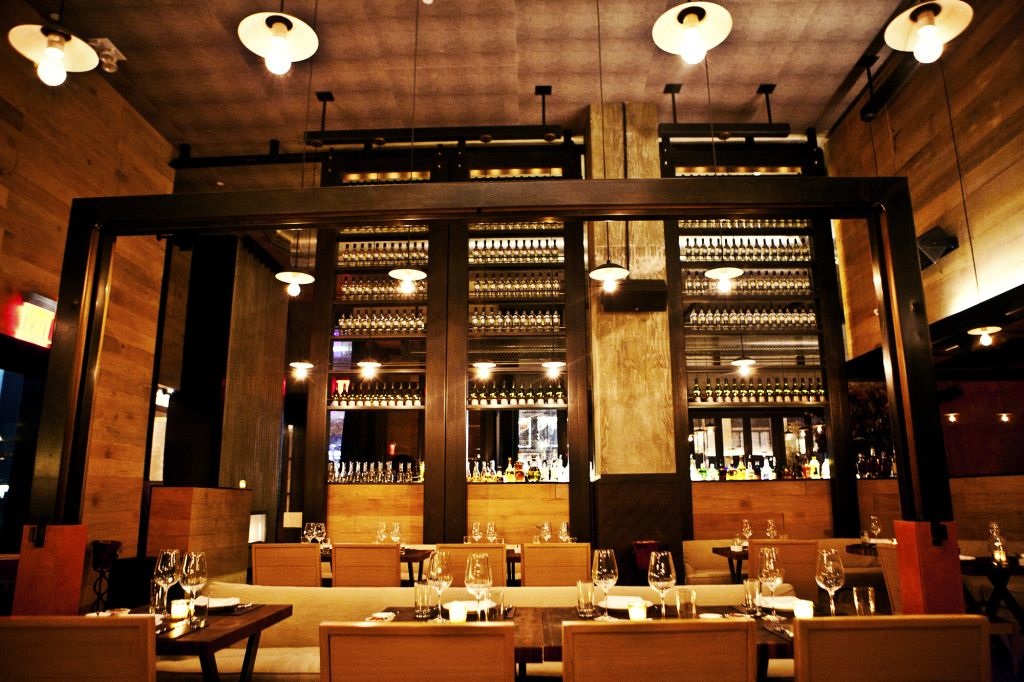 It's not quite as easy
as you might think to cook good Italian food in NYC, but from the
myriad examples of wonderful ristoranti
and trattorias in the city, the pretense that one had to be born and
raised in Italy to achieve authenticity crumbled as soon as American
cooks got their hands on the same ingredients Italians had been using
for the last two centuries. (As noted in the article above,
EATaly, with a branch in NYC, is no longer unique to Turin.)
Nevertheless, when you taste Italian food made by an Italian, via
Sardinia, like chef Marco Porceddu of the new Asellina, you will be
reminded that there's no substitute for being bred in an Italian
kitchen. Even his last name is evocative: in Sardinian dialect, porceddu refers to a roast suckling
pig.
It's not quite as easy
as you might think to cook good Italian food in NYC, but from the
myriad examples of wonderful ristoranti
and trattorias in the city, the pretense that one had to be born and
raised in Italy to achieve authenticity crumbled as soon as American
cooks got their hands on the same ingredients Italians had been using
for the last two centuries. (As noted in the article above,
EATaly, with a branch in NYC, is no longer unique to Turin.)
Nevertheless, when you taste Italian food made by an Italian, via
Sardinia, like chef Marco Porceddu of the new Asellina, you will be
reminded that there's no substitute for being bred in an Italian
kitchen. Even his last name is evocative: in Sardinian dialect, porceddu refers to a roast suckling
pig.His training in European kitchens must have prepared him for the large-scale of Las Vegas, where he'd worked for Steve Wynn, then opened his own restaurant there, Bella Luna. At Asellina, which is in the Gansvoort Hotel on Park Avenue, Porceddu is in charge of all the food prep, from room service to banquets, but his heart and soul are clearly at Asellina. You'll taste it the moment you bite into a tender Cerignola olive, stuffed with veal and parmigiano, dusted with semolina and fried--as luscious a morsel of goodness as you'll ever eat. So, too, the wood-fired meatballs with cannellini beans, culatello, and fontina, and sweetly savory
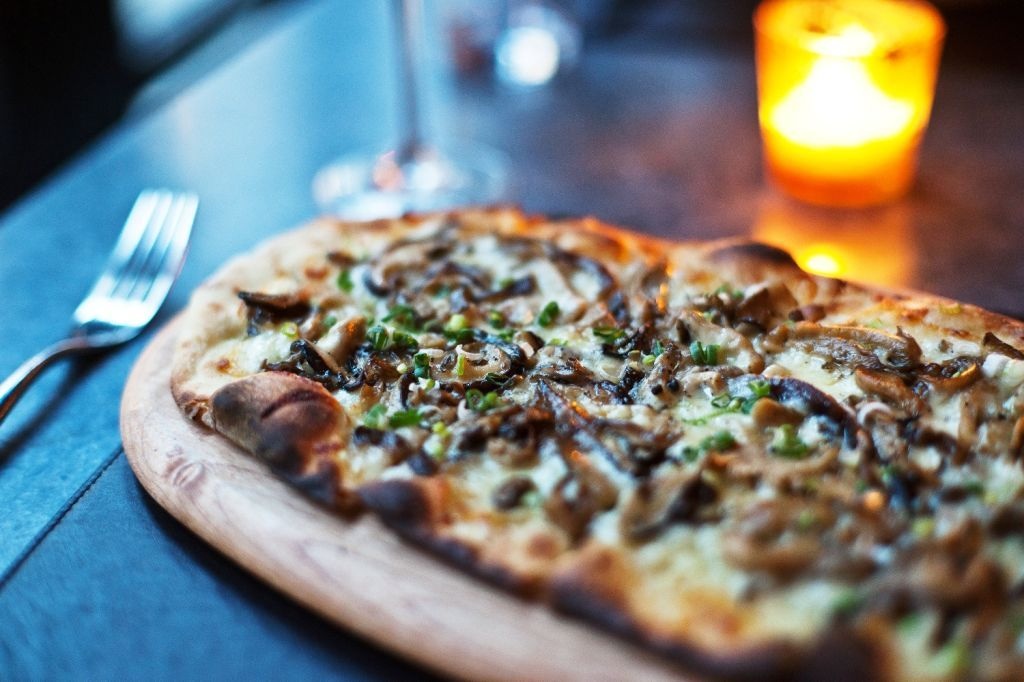 baked eggplant tortino with ricotta and cheese
fonduta. Variants of these might be found around town these days,
but this is how they should be done.
baked eggplant tortino with ricotta and cheese
fonduta. Variants of these might be found around town these days,
but this is how they should be done.Not quite so with the pizzas and flatbreads (left), which are indeed trendy flat, with less-than-intense flavors, including suckling pig and robiola, not as satisfying as pizza with a thicker, more pliant crust. The pastas, however, succeeded in convincing me that Porceddu has trained his staff well in the craft of making and saucing (not over saucing) dishes like tender spinach and ricotta ravioli with simple fresh sage, butter, and lemon zest. Saffron strozzapreti ("priest stranglers," colloquially so called because priests would gorge on the noodles when visiting parishioners for Sunday dinner) with shrimp, zucchini and a splash of brandy (below)--one of the best seafood pastas in the city. Also delicious was garganelli with a three meat ragù, wild fennel and pecorino sardo. Wide pappardelle came with a finely textured housemade sausage and sauteed porcini, though the mushrooms were overcooked and too soft.
For the secondi, seared chicken with prosciutto and
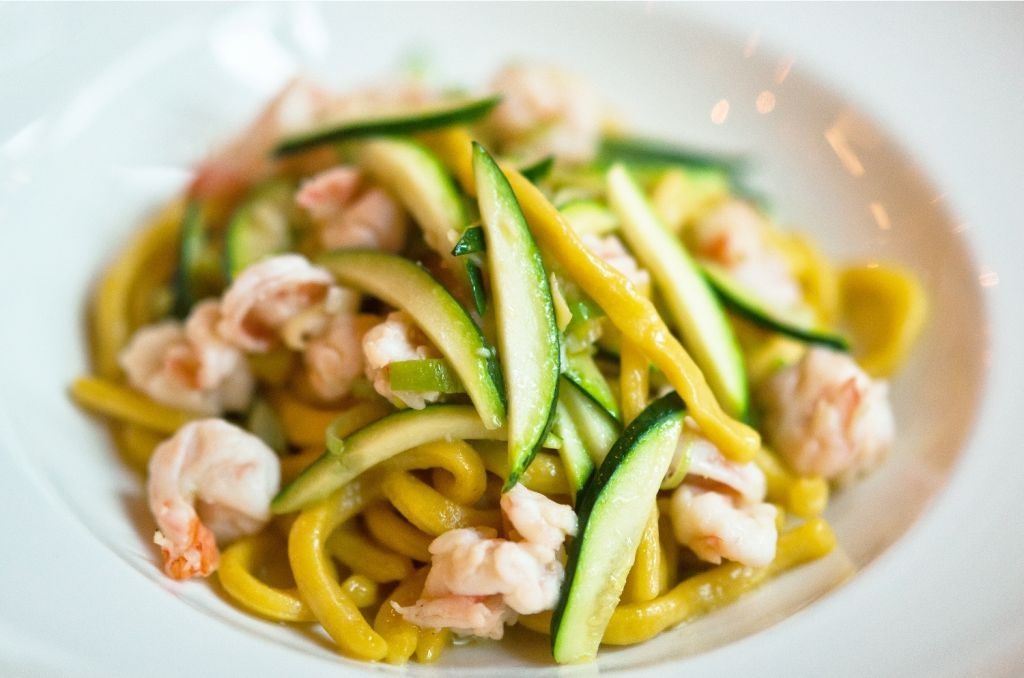 fresh sage, the fondly recalled saltimobocca style usually done
with veal, was very juicy, served with asparagus of the season.
Monkfish was equally as succulent and perfectly cooked, and stuffed
beef tenderloin with chanterelles, ubriaco
cheese and red wine had plenty of flavor. But lamp chops,
which were either oddly thin or pounded to be so, were overcooked and
livery, not helped by a soggy herb crust, marinated tomato skin and too
assertively acidic Champagne vinegar.
fresh sage, the fondly recalled saltimobocca style usually done
with veal, was very juicy, served with asparagus of the season.
Monkfish was equally as succulent and perfectly cooked, and stuffed
beef tenderloin with chanterelles, ubriaco
cheese and red wine had plenty of flavor. But lamp chops,
which were either oddly thin or pounded to be so, were overcooked and
livery, not helped by a soggy herb crust, marinated tomato skin and too
assertively acidic Champagne vinegar.What I'd really love to see on Porceddu's menu are his native Sardinian dishes, which no one in NYC ever does, like burrida seafood stew, malloreddus pasta, and seadas dessert pastries, not to mention porceddu itself.
Italian restaurants in NYC and in Italy used to serve less than thrilling desserts, but Asellina's are very good, with a vanilla-rich panna cotta, a moist round of cheesecake, a good chocolate torta with vanilla gelato, and a terrific tiramisù with savoiardi biscuits and Frangelico.
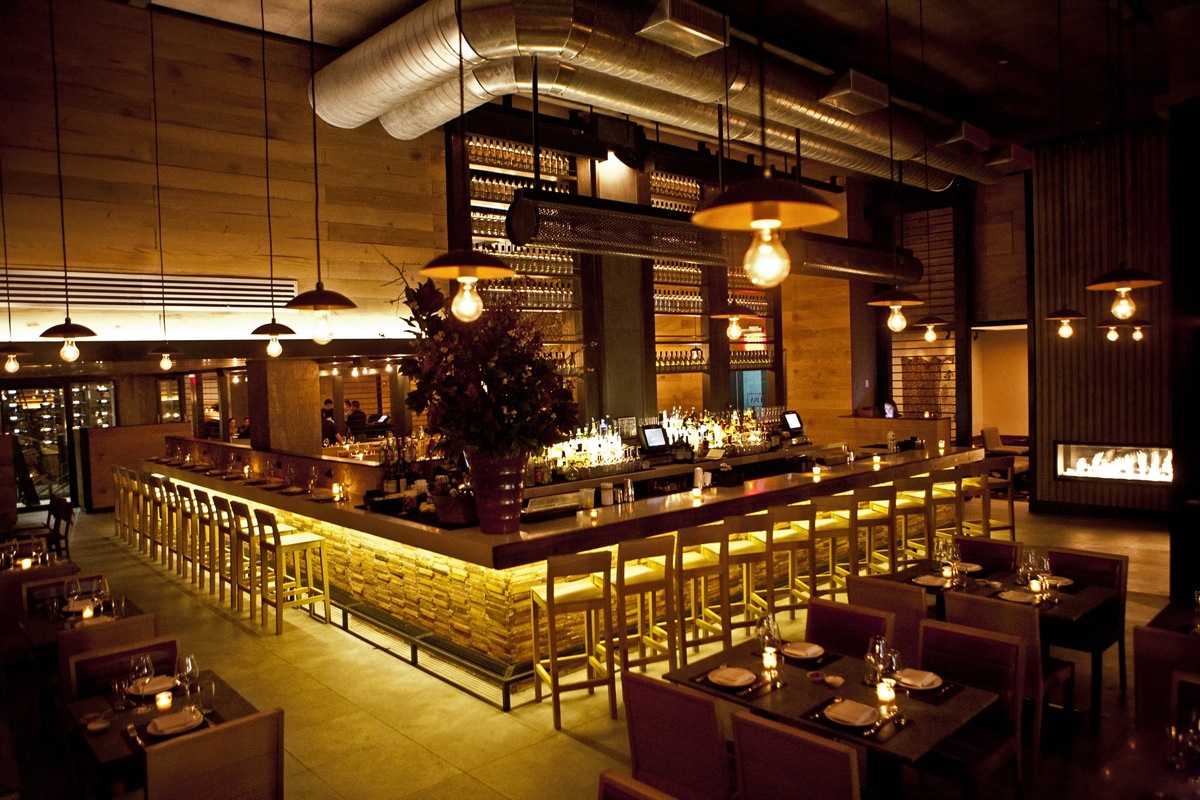
The wine list hits all the right notes, mostly Italian ones, and wines are offered by the quartino. The service staff couldn't be nicer, from greeting to seating, from wine knowledge to dish information. There was, however, considerable lag time between courses, more likely the kitchen's fault than the service staff.
Having thus rendered praise of Asellina's food, I must note that the place loses its authenticity as an Italian facsimile by virtue of its setting, décor, and focus on the vivacious bar scene up front (left). The designer, New York-based ICRAVE, has done a lot of work in Las Vegas, and Asellina shows the same swank and vibe, done in brick, stone, metal, and wood. The dining room is dark to begin with and darkens further as the night wears on, and the throbbing Euro-music is itself pumped up as it gets past eight o'clock--aspects more in line with a Vegas casino restaurant than a New York style. A DJ spins live music Wednesday and Saturday nights. Places with these entertainment effects are few and far between, if they exist at all, in Italy, but if places like NYC's Tau and Buddakan are to your liking, than you'll probably enjoy yourself. at Asellina. But many who truly love Italian food and atmosphere may be put off by the glitz.

MAN ABOUT TOWN
by
Christopher Mariani
Truffle Hunting in Le Marche, Italy
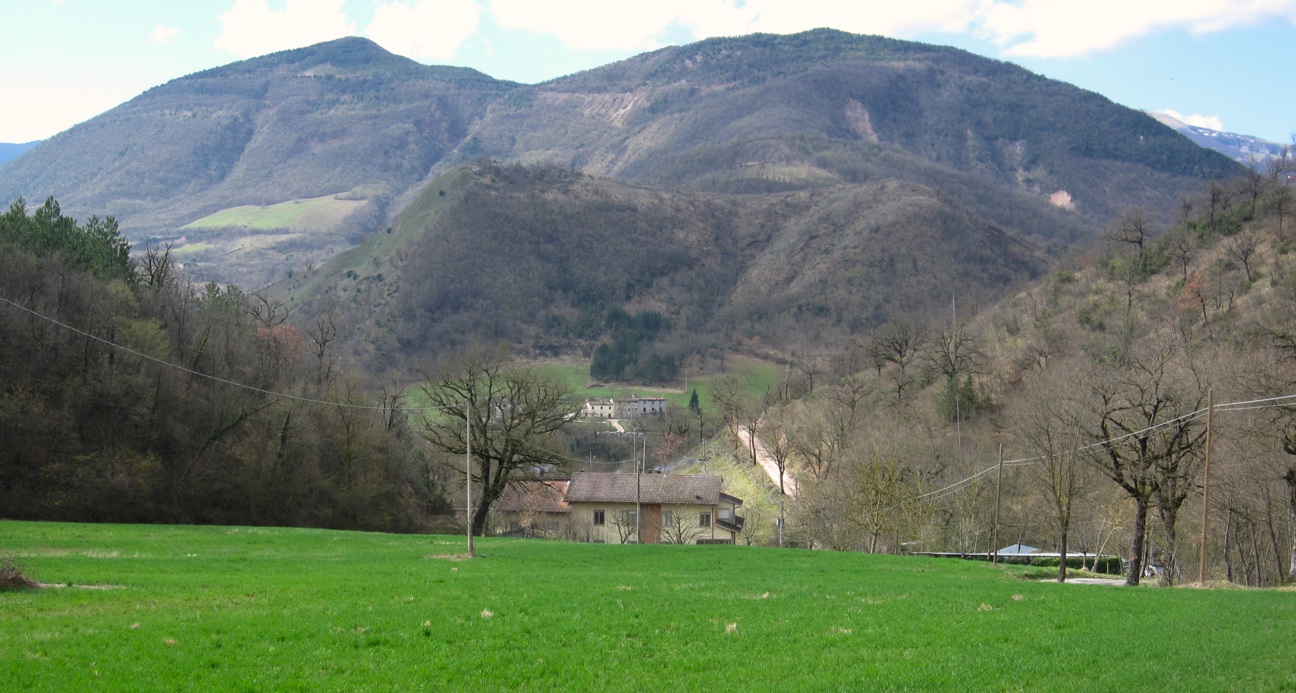
"Acqualagna, Italy"
Again I woke up early, but at least there was daylight, unlike the morning we visited the fish auction in Fano. I was with legendary restaurateur Tony May (below) and one of America’s famed wine writers, Anthony Dias Blue (he goes by Andy), as part of an annual GRI trip to Italy.
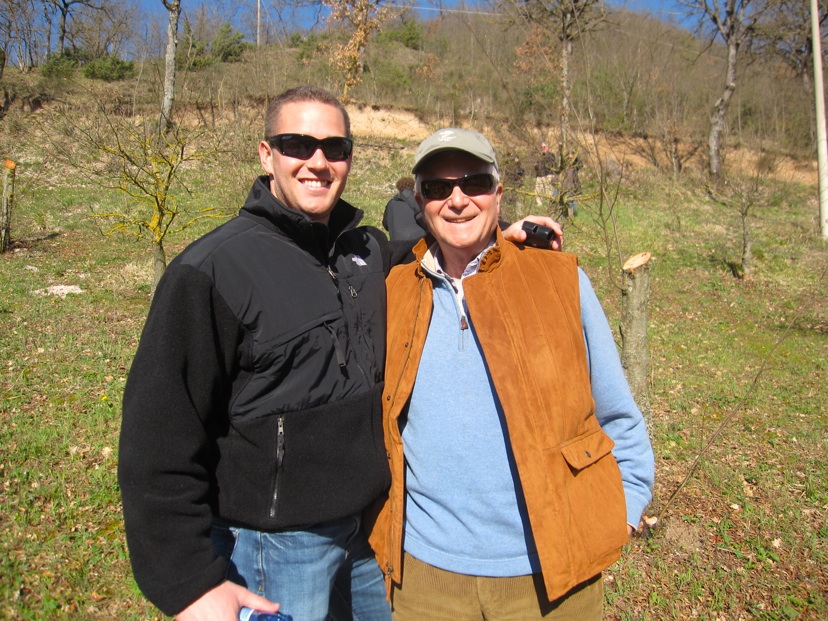 We
had been touring the beautiful Italian region of Le Marche, dining
nightly at
terrific Michelin-star restaurants and trattorias, tasting native wines
(mostly
white) and relying on espresso for energy. I’ve known Tony May for many
years but never did I know he doesn’t require sleep, nor is he affected
by
jetlag. The man touches down on Italian soil and he has the vigor
of a teenage
boy. The only time Tony took a break was while we sat down on a wooden
bench in
the seaside city of Pesaro while smoking cigars and gazing out into the
horizonof the Adriatic.
We
had been touring the beautiful Italian region of Le Marche, dining
nightly at
terrific Michelin-star restaurants and trattorias, tasting native wines
(mostly
white) and relying on espresso for energy. I’ve known Tony May for many
years but never did I know he doesn’t require sleep, nor is he affected
by
jetlag. The man touches down on Italian soil and he has the vigor
of a teenage
boy. The only time Tony took a break was while we sat down on a wooden
bench in
the seaside city of Pesaro while smoking cigars and gazing out into the
horizonof the Adriatic.
That morning as the sun awakened we drove to one of Italy’s highest truffle producing capitals, Acqualagna. There is public land where only licensed truffle hunters can hunt, and there are truffle farms where truffles are grown in semi-controlled environments and harvested year round.
The idea of a truffle farm may seem foreign to most who think of truffle hunting as rummaging through the forest with pigs in search of baseball-size truffles, which, is not too far off from the truth. Except that in Italy pigs have been replaced by dogs trained to sniff out the intense aromas of what essentially is a fungus. Dogs generally don’t eat the truffles, thank god, unlike pigs that salivate at the thought. Imagine that your pig locates a truffle easily worth a few hundred dollars and bites into it like an apple! This would be a sad day for any hunter.
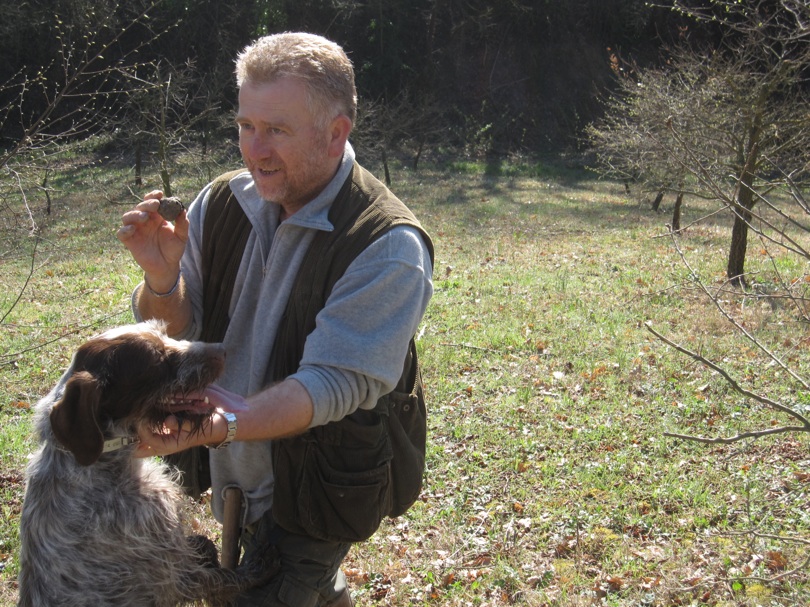 Truffle
farms
are
filled
with
specific
oak
trees
trimmed to stay small,
concentrating all nutrients and water in the roots of the tree. It is
underground where the truffle spores find a home by attaching
themselves to the
roots and feeding off them for nutrition. The spores and fungus spread
on
these farms and almost every tree has hidden treasures underneath the
soil it
stands on. The question is, which tree on any given day has a truffle?
An important
question that must be answered quickly, considering the shelf life of a
truffle
is far from long.
Truffle
farms
are
filled
with
specific
oak
trees
trimmed to stay small,
concentrating all nutrients and water in the roots of the tree. It is
underground where the truffle spores find a home by attaching
themselves to the
roots and feeding off them for nutrition. The spores and fungus spread
on
these farms and almost every tree has hidden treasures underneath the
soil it
stands on. The question is, which tree on any given day has a truffle?
An important
question that must be answered quickly, considering the shelf life of a
truffle
is far from long.
During our visit to a truffle farm in Acqualagna, owner Giorgio Remedia and his faithful companion Bobby (right) showed us which trees have truffles and which trees have lots of truffles. The farm is cultivated and each tree is planted in a row staggered by at least ten yards. This offers the roots of all trees a chance to grow large and hopefully produce lots of truffles.
Giorgio
and Bobby led the way as we marched across the muddy field. We
approached a
steep hill facing the sun where the oaks were planted in rows that went
on for
a hundred yards. Bobby’s tail began to whip with great excitement for
the start
of a hard day's work. Giorgio slowly unclipped Bobby’s leash and before
you knew
it Bobby darted across the field ripping up chunks of dirt with each
stride.
He lapped the field once or twice before narrowing his 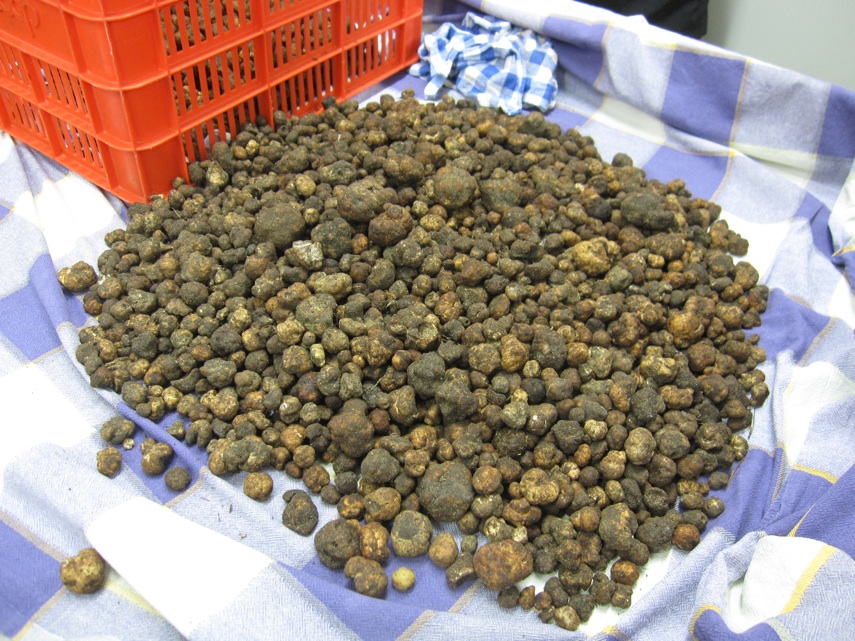 search to a specific
area where he smelled something. Quickly Giorgio sprinted towards the
tree
Bobby was sniffing and asked, “Where’s the truffles Bobby?” Bobby began
to
shake with excitement, he knew there was a truffle within a paws reach.
Bobby suddenly
started digging in a crazed state right before Giorgio pulled Bobby
back to
ensure the safety of the truffle. Giorgio explained that the slightest
graze of
Bobby’s claw to the truffle immediately dissolves the value of the
truffle
because it would be flawed and exposed to bacteria and decay. Giorgio,
still
holding the wide-eyed Bobby back, brushed a thin layer of dirt away and
picked
up a black truffle the size of a tennis ball with his bare hands. Bobby
was then rewarded with a dog treat before he rushed off in search
for another treat worthy
truffle.
search to a specific
area where he smelled something. Quickly Giorgio sprinted towards the
tree
Bobby was sniffing and asked, “Where’s the truffles Bobby?” Bobby began
to
shake with excitement, he knew there was a truffle within a paws reach.
Bobby suddenly
started digging in a crazed state right before Giorgio pulled Bobby
back to
ensure the safety of the truffle. Giorgio explained that the slightest
graze of
Bobby’s claw to the truffle immediately dissolves the value of the
truffle
because it would be flawed and exposed to bacteria and decay. Giorgio,
still
holding the wide-eyed Bobby back, brushed a thin layer of dirt away and
picked
up a black truffle the size of a tennis ball with his bare hands. Bobby
was then rewarded with a dog treat before he rushed off in search
for another treat worthy
truffle.
This
process went on all morning, and just a few hours later we had a small
canvas
bag filled with black truffles of all different shapes and sizes. It
was not
the season for white truffles but interestingly enough Girorgio
explained to us
how white truffles are only found in Italy and the reason for this is
still
unknown. He told many stories of truffle experts who uplifted entire
plots of
soil and roots known to have white truffle spores attached to them and
relocated the land to different countries around the world, yet not one
truffle
was produced. It is a mystery that doesn’t seem to make sense. Do
the spores know they are leaving their beloved Italy and decide to
rebel by not
turning into truffles? 
That afternoon after saying goodbye to Giorgio and Bobby we headed to the Acqualagna Tartufi laboratory for a quick tour. As we pulled into the parking lot there was a hint of truffle in the air. When we opened the doors to the laboratory it was as if we had been smacked in the face by a giant truffle. The rooms were filled with truffle essence and shelves stocked with jarred truffle oil, creams, silky cheeses topped with shaved truffles, pasta infused with truffle and my favorite, a glass jar of truffle honey. I bought a jar for my mother and we drizzled it onto chunks of Parmigiano Reggiano cheese when I returned home.
The
lab room was centered around untouched truffles, mounds that stood one
foot tall
and three feet wide. It was like truffle heaven and I didn’t want to
ever
leave. Stainless steel machines surrounded us and the aroma only
thickened. We
eventually 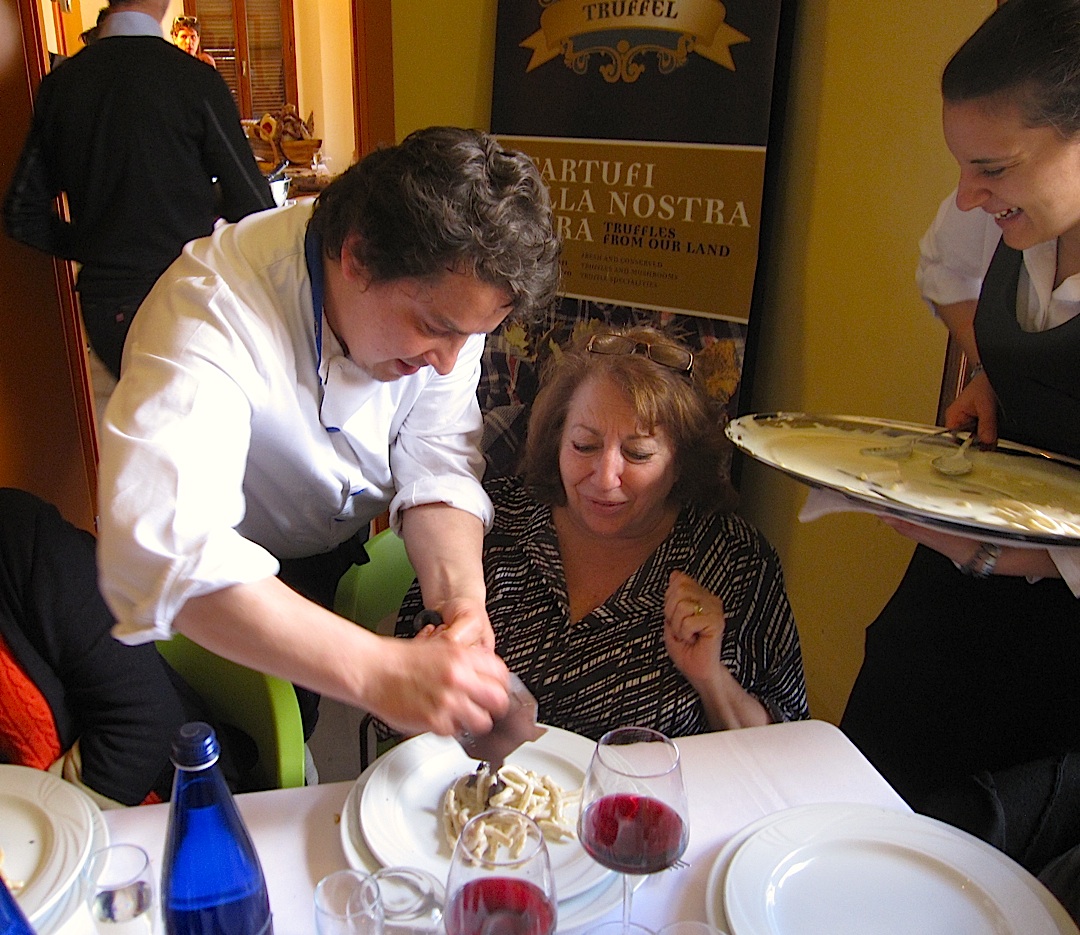 had to leave, against our will, as we stumbled back to the
car in a
truffle haze.
had to leave, against our will, as we stumbled back to the
car in a
truffle haze.
It
was then off to Il Palazzo del Gusto for a truffle-inspired lunch. One
inch
thick slices of Italian bread were soaked in a truffle cream sauce and
topped
with shaved truffles. It was like truffle bread pudding with a rich
liquid
consistency. Fluffy eggs were covered with black truffle shavings (above) and washed
down with mouthfuls of crisp, cold white wine. Chef then brought out
plates of
fresh pasta and personally shaved small mountains of truffle on top. I
don’t remember
when it all stopped.
After visiting
Acqualagna, I can say with full confidence, I am displeased when a
restaurant claims to serve a dish with truffles yet there is not one
truffle on
the plate. You cannot call mash potatoes "truffle mash potatoes" simply
because
you have added a drizzle of truffle oil and a pad of truffle butter. It
is not
right! A dish that claims to have truffles must have truffles, and
whenever I
start to think about that marvelous day in Acqualagna, I call up Tony
May and ask him if he has
a table for me at his NYC restaurant SD26,
where
chef
Matteo
Bergamini
is
never
cheap
with the truffles.
ITALIAN WINE SALES SOAR

by John Mariani
Do I lie?
In my new book,
How Italian Food Conquered the World, I spend a chapter and more
telling the story of how Italian wines went from straw-covered bottles
of cheap Chianti through fizzy Lambrusco on ice, to Bolla Soave,
and finally, in the late 1970s to the import of great wines like Gaja
Barbarescos and the Super Tuscans. Led by then Italian Trade
Commissioner to NYC, Dr. Lucio Caputo, Italian wine sales went from
142,000 hectoliters in 1970 to two million by 1980. Sine then
there's been no stopping the increases in Italian wine sales, not just
in the U.S. but in all markets outside of Italy itself. Today Italy is
the largest exporter of wines to the U.S. Blow the bugles!
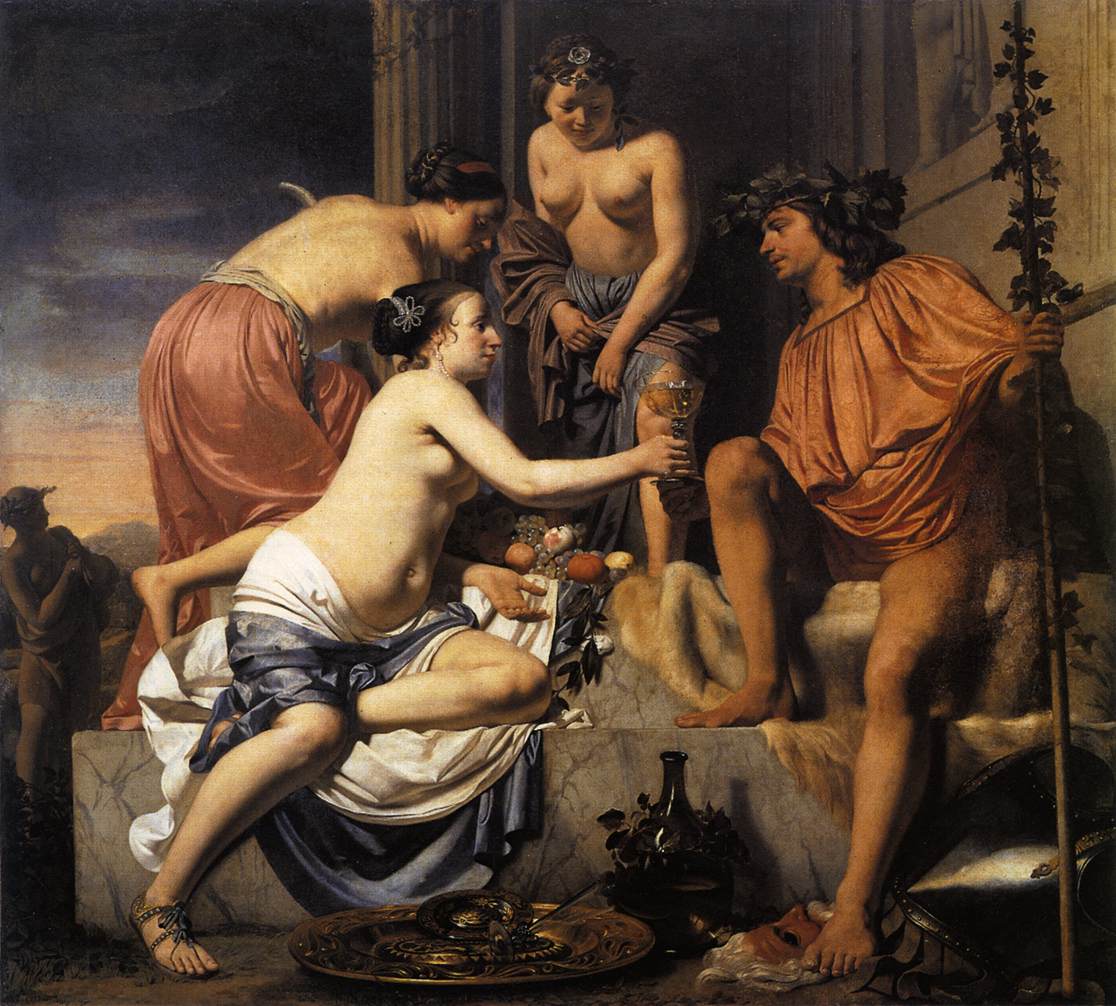 Now
comes a report by the Italian Wine and Food Institute, whose president
is that same Lucio Caputo, that in the first trimester of 2011, Italy
experienced an increase of 28.7% in
quantity and 27.1% in value, rising to
610,570 hectoliters for a value of
$297,455,000 during the first trimester of 2011, with America
further distancing
itself from Australia, the second largest exporter to the U.S. (In
fact,
Australia reported a decrease of 8.7% in value this year.)
Now
comes a report by the Italian Wine and Food Institute, whose president
is that same Lucio Caputo, that in the first trimester of 2011, Italy
experienced an increase of 28.7% in
quantity and 27.1% in value, rising to
610,570 hectoliters for a value of
$297,455,000 during the first trimester of 2011, with America
further distancing
itself from Australia, the second largest exporter to the U.S. (In
fact,
Australia reported a decrease of 8.7% in value this year.)
According to Caputo (below), "A major contribution to
that success was given by the notable increase of bulk
wine exports – mainly Pinot Grigio exported to California – which rose
from
11,270 hectoliters to 51,650 hectoliters during this ongoing year. The
value
rose from $2,264,000 to $8,263,000. There was an increase of 358.4% in
quantity
and of 265.1% in value."
Meanwhile,
imports
from
France
rose
slightly
from
150,700
hectoliters
to
150,920
hectoliters
this
trimester, and its value increased  from
$126,115 to $131,173,000.
Therefore, France has experienced an increase of 0.1% in quantity and
of 4.1%
in value. Spain, however, experienced a 73% increase in quantity and
27.6% increase
in value.
from
$126,115 to $131,173,000.
Therefore, France has experienced an increase of 0.1% in quantity and
of 4.1%
in value. Spain, however, experienced a 73% increase in quantity and
27.6% increase
in value.
In addition, Italian sparkling wines
(spumante) increased from 32,620 hectoliters for a value of
$19,997,000 in the first trimester of 2010, to 50,180 hectoliters for a
value
of $29,750,000 this year so far. Italy increased 53.8% in quantity and
48.9% in
value.
Stats are
of enormous interest to growers, importers, and distributors, but for
the average wine drinker, these above show how wholeheartedly Americans
have embraced Italian wines. The figures do not really speak to
the premium Italian wine market--as noted, cheap pinot grigio to
California rose substantially--but there is no question in Americans'
minds that Italian wines are good value and, possibly just as
important, very very consistent. At the higher end of the market,
Italian wines are unbeatable, especially when you think that very few
retail for more than $100, while French Bordeaux and Burgundy prices
reach into the thousands of dollars for a single bottle.
Thus, Italian wine has at
least conquered America as of this new decade. The rest of the
world will come along soon.
 GOOD TO KNOW, JUST IN CASE
GOOD TO KNOW, JUST IN CASE"Did you ever
see the movie called 127
Hours, where the guy has to saw off his own arm? [While I watched
it,]
I wanted him to know how to debone a chicken. He kept trying to cut
through the
bone. I wanted him to know he could go in through the joint and pop it
out."--Gabrielle Hamilton, chef-owner of Prune, NYC.
BANG, BANG, YOU'RE DEAD, AND YOU ARE NOT
GOING TO TERRORIST HEAVEN!
The makers of Silver Bullet Gun Oil say their product contains USDA liquefied pig fat, "a highly effective counter-Islamic terrorist force multiplier." According to the firm's owner, who calls himself "The Midnight Rider," a bullet so oiled "effectively denies entry to Allah's paradise to an Islamo-fascist terrorist," and that "thousands of bottles of Silver Bullet Gun Oil have been distributed since July of 2004 by its creator to members of all U.S. Military branches," and was likely to have been used to kill Osama Bin Laden. When asked about this possibility, a spokesman for the U.S. Army's weapons-procurement command said he was unfamiliar with Silver Bullet, conceding only that a soldier or marine could theoretically purchase the oil on his or her own and use it on the battlefield, noting, "We do not promote discrimination against any race or religion, only terrorists."
❖❖❖
Any
of John Mariani's books below
may be ordered from amazon.com.
" A fact-filled,
entertaining history [that] substantiates its title with hundreds of
facts in this meaty history of the rise of Italian food culture around
the
globe. From Charles Dickens's journey through Italy in 1844 to
20th-century
immigrants to America selling ice cream on the streets of New Orleans,
Mariani
constantly surprises the reader with little-known culinary anecdotes
about
Italy and its people, who have made pasta and pizza household dishes in
the
U.S. and beyond."--Publishers Weekly "Equal
parts
history,
sociology,
gastronomy,
and
just
plain
fun,
How
Italian
Food
Conquered
the
World
tells
the
captivating
and
delicious
story
of
the
(let's
face
it)
everybody's
favorite
cuisine
with
clarity,
verve
and
more
than
one
surprise."--Colman
Andrews,
editorial
director
of
The
Daily Meal.com. "A
fantastic and fascinating read, covering everything from the influence
of Venice's spice trade to the impact of Italian immigrants in
America and the evolution of alta cucina. This book will serve as a
terrific resource to anyone interested in the real story of Italian
food."--Mary Ann Esposito, host of PBS-TV's Ciao Italia. "John
Mariani
has
written
the
definitive
history
of
how
Italians
won
their
way
into
our
hearts,
minds,
and
stomachs.
It's
a
story
of
pleasure
over
pomp
and
taste
over
technique."--Danny
Meyer,
owner
of
NYC
restaurants
Union
Square
Cafe,
Gotham
Bar
&
Grill,
The
Modern,
and
Maialino.
|
 |
 |
 |
 |
 |
 |
 |
 |
FEATURED LINKS: I am happy to report that the Virtual Gourmet is linked to four excellent travel sites:
 Everett
Potter's
Travel
Report:
Everett
Potter's
Travel
Report: I consider this the best and savviest blog of its kind on the web. Potter is a columnist for USA Weekend, Diversion, Laptop and Luxury Spa Finder, a contributing editor for Ski and a frequent contributor to National Geographic Traveler, ForbesTraveler.com and Elle Decor. "I’ve designed this site is for people who take their travel seriously," says Potter. "For travelers who want to learn about special places but don’t necessarily want to pay through the nose for the privilege of staying there. Because at the end of the day, it’s not so much about five-star places as five-star experiences."

 Eating
Las
Vegas is the new on-line site for Virtual Gourmet
contributor John
A. Curtas., who since 1995 has been commenting on the Las Vegas food
scene and reviewing restaurants for Nevada Public Radio. He is
also
the restaurant critic for KLAS TV, Channel 8 in Las Vegas, and his past
reviews can be accessed at KNPR.org.
Click
on
the
logo
below
to
go
directly
to
his
site.
Eating
Las
Vegas is the new on-line site for Virtual Gourmet
contributor John
A. Curtas., who since 1995 has been commenting on the Las Vegas food
scene and reviewing restaurants for Nevada Public Radio. He is
also
the restaurant critic for KLAS TV, Channel 8 in Las Vegas, and his past
reviews can be accessed at KNPR.org.
Click
on
the
logo
below
to
go
directly
to
his
site.
www.EatingLV.com

Tennis Resorts Online: A Critical Guide to the World's Best Tennis Resorts and Tennis Camps, published by ROGER COX, who has spent more than two decades writing about tennis travel, including a 17-year stretch for Tennis magazine. He has also written for Arthur Frommer's Budget Travel, New York Magazine, Travel & Leisure, Esquire, Money, USTA Magazine, Men's Journal, and The Robb Report. He has authored two books-The World's Best Tennis Vacations (Stephen Greene Press/Viking Penguin, 1990) and The Best Places to Stay in the Rockies (Houghton Mifflin, 1992 & 1994), and the Melbourne (Australia) chapter to the Wall Street Journal Business Guide to Cities of the Pacific Rim (Fodor's Travel Guides, 1991).


The Family Travel Forum
- A community for those who
"Have Kids, Still Travel" and want to make family vacations more fun,
less work and better value. FTF's travel and parenting features,
including
reviews of tropical and ski resorts, reunion destinations, attractions,
holiday
weekends, family festivals, cruises, and all kinds of vacation ideas
should be
the first port of call for family vacation planners. http://www.familytravelforum.com/index.html
ALL YOU NEED BEFORE YOU GO

nickonwine: An engaging, interactive wine column by Nick Passmore, Artisanal Editor, Four Seasons Magazine; Wine Columnist, BusinessWeek.com; nick@nickonwine.com; www.nickonwine.com.

MARIANI'S VIRTUAL GOURMET NEWSLETTER is published weekly. Editor/Publisher: John Mariani.
Contributing Writers: Christopher
Mariani, Robert Mariani,
John A. Curtas, Edward Brivio, Mort
Hochstein, and
Brian Freedman. Contributing
Photographers: Galina Stepanoff-Dargery, Bobby Pirillo. Technical
Advisor:
Gerry McLoughlin.
HOME
| CURRENT ISSUE |
ARCHIVES
| QUICK
BYTES | SUBSCRIBE
| ABOUT US
|
BOOKS
| CONTACT
|
ADVERTISE
© copyright John Mariani 2011
